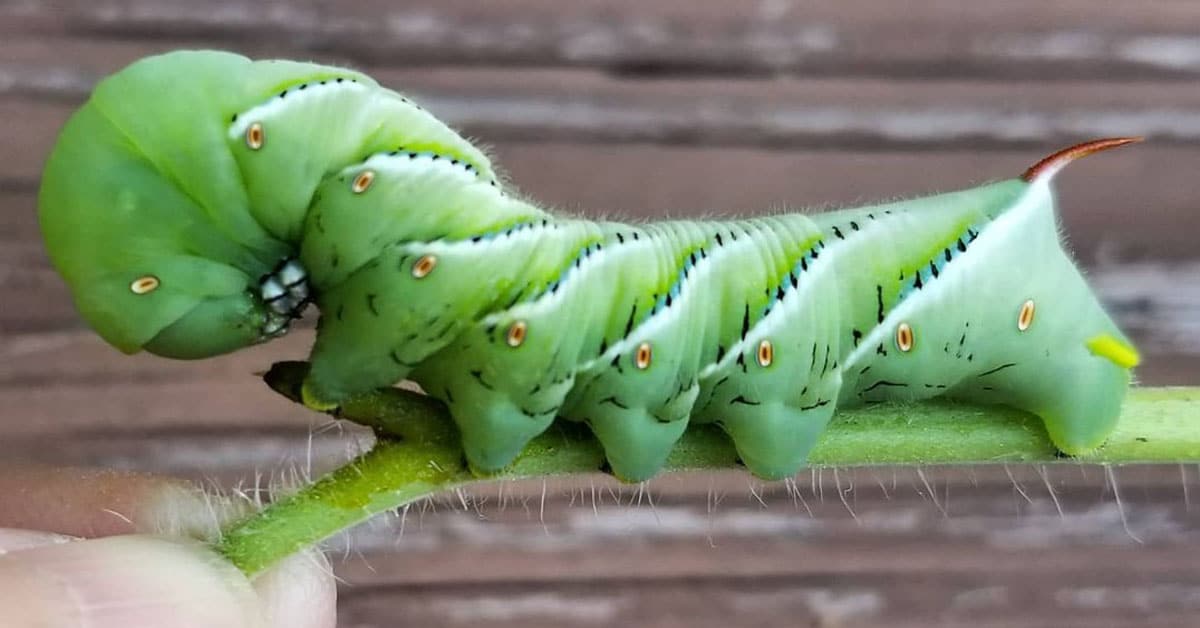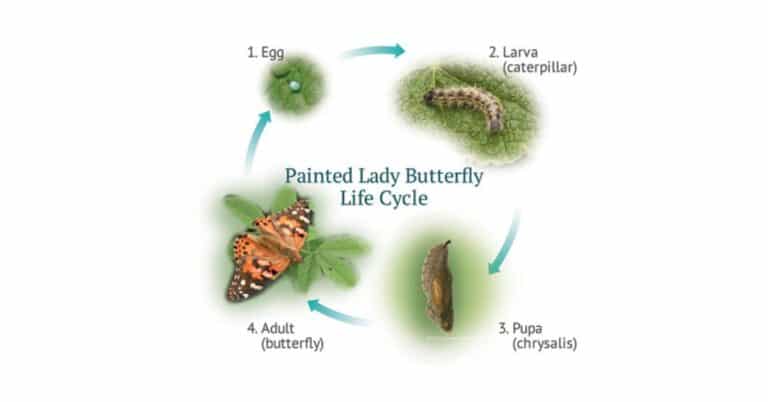Tomato Hornworm Life Cycle & Tips to Prevent
People who’re tired of looking for tomato hornworms in their gardens often try to learn more about the tomato hornworm life cycle. But did you know that the official name for tomato hornworms is Manduca quinquemaculata?
This specific name comes from the long, horn-like tail on the back of those larvae or caterpillars. They do consume tomato plants, but they also consume potatoes, eggplants, and capsicums, which are all members of the nightshade, scientifically known as the Solanaceae family.
The larval stage and the adult stage of the tomato hornworm life cycle follow a full metamorphosis developmental pattern, and they both have entirely distinct appearances. Below, we will explore the tomato hornworm life cycle and learn some interesting facts about this insect.
What Is a Tomato Hornworm?
Before exploring the tomato hornworm life cycle, let’s first briefly learn more about those creatures. Sometimes people confuse tomato hornworms with the related tobacco hornworms (Manduca sexta). The patterns on the bodies of these caterpillars are a crucial factor in identifying them. Tobacco hornworms feature a red horn and diagonal white lines, whereas tomato hornworms have yellow or white V-shaped patterns.
The five-spotted hawk moth’s caterpillar is the tomato hornworm. The worm is distinguished by having a horn on its back, which gives it a commanding appearance. Although it is harmless to people, the tomato hornworm is a well-known pest of garden produce.
The adult moths of tomato hornworm are also known as hummingbird moths, five-spotted hawkmoths, or sphinx moths. They have a rather huge body, and on either side of their belly are five enormous orange markings. The six spots down each side of the adult tobacco hornworm moths’ abdomen, which are frequently a more pronounced, vivid orange hue, set them apart from other moths of the same species.
Hornworms may grow up to 5 inches long, which might be shocking to discover at first. When they are caterpillars or larvae, they cause the most harm.
There’s a strong likelihood that if you’ve ever grown tomatoes, you’ve battled with these pest green caterpillars. Tomato hornworms are a type of garden pest, and they are present across much of the United States and southern Canada. Those species have the potential to quickly damage tomato harvests. They also consume eggplants, peppers, potatoes, tobacco, and other members of the Solanaceae family. They are highly adept at blending in with the lush greenery and continuously feeding, producing fruit and leaves that are patchy and chewed.
4 Stages of Tomato Hornworm Life Cycle
There are four stages in the tomato hornworm life cycle: egg, caterpillar or larva, pupa, and adult moth. The tomato hornworm eggs are smaller than 0.039 inches long and have a pearly light green to greenish-yellow tint. When the caterpillars molt, they begin to consume ferociously.
As they develop, they start to outgrow their exoskeleton, often known as their “hard skin,” and molt in order to produce a new one. An instar is an interval between each molting process. Before becoming a pupa, tomato hornworm caterpillars go through five instars.
The pupa grows underground in a constrained area. The caterpillar’s body separates during pupation and then reforms into an adult moth. The moths are nocturnal and fly around, consuming floral nectar and looking for partners after emerging from their puparium. The tomato hornworm life cycle then restarts when the female leaves the pair after mating to lay her eggs on a nightshade plant that the larvae like eating.
Now, let’s explore all those phases of the hornworm life cycle in more detail.
Egg Stage
The first stage of the tomato hornworm life cycle is an egg. One to five eggs are laid by a moth per plant. She uses an extended device on her rear called an ovipositor to delicately place her eggs on the undersides of leaves. She may produce 1,000–2,000 tomato hornworm eggs throughout her lifespan. Typically, 3 to 5 days after eggs are placed, they begin to hatch. Larvae that have just emerged in the wild will start eating the leaf where they were placed.
Caterpillar
Two or three of these voracious larvae, sometimes known as tomato caterpillars, can completely destroy all the leaves on a plant. They occasionally eat the fruit as well, depending on how hungry they are. Instead of drilling tiny holes in the fruit, they leave big, gaping sores on the surface after eating it.
They occasionally relocate to a new plant. In most cases, they won’t do so until their sixth instar. Until they are three or four inches long, at this stage of the tomato hornworm life cycle, they eat continuously for three to four weeks.
The caterpillar molts between each instar, removing its skin to make room for future development. Larvae in the first instar are typically 7 mm long. They can grow as long as 70 mm by the end of the fifth instar. Caterpillars need to be under continual light at a temperature of 27° C (81° F) during this period of development. If not, caterpillars will undergo diapause after they pupate, extending the pupal stage from weeks to months.
Pupa Stage
When fully developed, caterpillars drop from the plant to the ground and burrow their pupation chamber four to six inches deep into the dirt. This is when the next part of the tomato hornworm life cycle begins.
There are two generations of larvae each summer. During the middle of the summer, first-generation tomato hornworm pupae emerge after a two-week pupation period. The moths emerge in the spring from the second generation’s pupae, which spend the winter in the soil.
The caterpillar’s transformation into an adult moth begins at this stage. Following pupation, the pupal case’s exterior displays the external characteristics of the adult moth. The fact that the pupae’s abdomens move despite their apparent rigidity and inactivity surprises many people.
Tomato Hornworm Moth
The adult moths will start to emerge one to two weeks after the pupae have been introduced to the environment. This is the last stage of the tomato hornworm life cycle. Adults will crawl up a branch or other vertical surface after emerging to spread their wings.
The moths have four to five inches of width on their wings. These big moths can fly well and quickly. The average adult’s life span is 2 to 3 weeks. The females start laying their eggs on the underside of leaves on the third night following emergence.
They can sip nectar from flowers that bloom at night because they have a lengthy proboscis mouthpiece. Despite the caterpillars’ severe devastation, many plants depend on moths for pollination. Adults have a long lifespan.
Habitat and Diet Of Tomato Hornworm
The five-spotted hawk moth’s natural habitat is Australia and North America. It can be discovered throughout these two continents. In contrast to the tobacco hornworm, which is more common in the south, five-spotted hawk moths and their larvae are more common in the northern United States.
The tomato plant is the preferred one in most stages of the tomato hornworm life cycle. However, they may also consume other members of the Solanaceae family, including tobacco, eggplant, potatoes, and peppers. Tomato hornworms may consume weeds including jimsonweed, horsenettle, and nightshade. However, this is less common.
As adults, they consume nectar from blooming plants, including Oenothera caespitosa, Mirabilis multiflora, and Datura meteloides. These plants’ fragrant white blossoms draw the moths to them.
How to Prevent Tomato Hornworm in Your Garden
As already mentioned above, tomato hornworms bring serious harm to the plants by eating away at the foliage and, in certain circumstances, eating holes in the fruit. These worms are huge, especially in the late stages of the tomato hornworm life cycle. All this makes it easy to see an infestation. Additionally, getting rid of them is not too difficult. Picking them off the plants as you discover them could be the simplest and most efficient strategy.
A natural bacterium called Bacillus thuringiensis is frequently used by gardeners to treat severe infestations. By paralyzing the worm’s digestive tract, this bacterium prevents them from eating. This is comparable to other low-risk insecticides like Spinosad and insecticidal soap. These insecticides are superior to broad-spectrum pesticides like bifenthrin, lambda-cyhalothrin, cyfluthrin, and permethrin since they don’t harm other insects.
As an alternative, you might introduce predatory insects like ladybugs or green lacewings to your garden. They feed on tomato hornworm eggs and their young. This type of caterpillar is also a food source for some wasp species, such as paper wasps.
There are several natural predators for this caterpillar. To get them off the plant, gardeners may let chickens and other birds loose in the area. Similar to this, several parasitic braconid wasp species target the hornworms as well. Usually, they deposit their eggs on the hornworms’ backs. When the worm hatches, the wasp larvae will eat it.
Final thoughts
You could have tomato hornworms if you notice leaves with significant defoliation, consumed blooms, or scars on fruit surfaces. Due to the decreased leaf cover, sunscald damage to the fruit is also a possibility. In this case, you may need to act quickly to save your crops. Fortunately, if you have a deep understanding of the tomato hornworm life cycle, eliminating them from your garden gets way easier.

Nato is a content writer and researcher with a background in psychology who’s eager to explore the wonders of nature. As a travel enthusiast and animal lover, she hopes to inspire others to discover and cherish the beauty and importance of the natural world.


